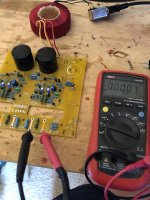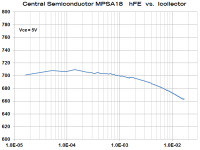Lets not confuse NAP90 with NAIT2 or NAIT3. They have similar power amplifier topology and semis but NAIT meant an integrated amp. NAP meant a simple power amp with the total 4R power output rating making up the model number. So NAP90 means 45+45W/4 Ohms and a larger transformer. NAIT2,3 are only around 30W/4R, as the table linked above indicates. The original NAIT, often referred to as Nait1, has somewhat less power than either.
Last edited:
Nait 3 on China Ali pcbLets not confuse NAP90 with NAIT2 or NAIT3. They have similar power amplifier topology and semis but NAIT meant an integrated amp. NAP meant a simple power amp with the total 4R power output rating making up the model number. So NAP90 means 45+45W/4 Ohms and a larger transformer. NAIT2,3 are only around 30W/4R, as the table linked above indicates. The original NAIT, often referred to as Nait1, has somewhat less power than either.
Without output transistors Vout on photo in attachment
Attachments
I'm listening BC139c&BC550c. I couldn't say there are any difference. I missed or something. I have another mono kit (NAP200), all LTP transistors are MPSA18. It's better sound than nap140. But, different design.
I guess you meant BC239&BC550c. As said earlier, there shouldn't really be any difference in performance in the application if they measure within specification and are similarly matched. However, if you bought them from a Chinese online seller, there may not actually be any difference (apart from markings) either. If they are appropriately biased and operating in the same circuit, you could expect any commonly used, low noise type transistors to sound the same. Otherwise, they may not be working in the same linear region of their operating curves and the circuit could need modification to suit.
Small signal transistors are typically all produced with similar manufacturing processes. As long as the resultant products meet or exceed a particular set of specifications, you may find that there is no difference between batches marked BC239, BC549, BC550 or BC546. Add those types to the similar low noise types in the US 2Nxxxx and Japanese 2SCxxxx etc. series and we find that there is little practical difference for DIY purposes there either. Manufacturers though, have to consider quality assurance, statistical variations and their own legal responsibilities when they specify any semi or component. That means a lot more care needs to be taken with who made the parts, their quality systems, documentation and reputation. As required by insurers and laws, they will only fit genuine, fully specified parts with traceable markings or other features, for the purpose.
As DIYs, we probably don't see that info or even think about it - only the part number and price
Small signal transistors are typically all produced with similar manufacturing processes. As long as the resultant products meet or exceed a particular set of specifications, you may find that there is no difference between batches marked BC239, BC549, BC550 or BC546. Add those types to the similar low noise types in the US 2Nxxxx and Japanese 2SCxxxx etc. series and we find that there is little practical difference for DIY purposes there either. Manufacturers though, have to consider quality assurance, statistical variations and their own legal responsibilities when they specify any semi or component. That means a lot more care needs to be taken with who made the parts, their quality systems, documentation and reputation. As required by insurers and laws, they will only fit genuine, fully specified parts with traceable markings or other features, for the purpose.
As DIYs, we probably don't see that info or even think about it - only the part number and price

Hi, everyone!
I can fully confirm that the differential pair of NAP200 is using MPSA18, not BC239. BC239 is the differential pair used in the old model (chrome bumper or olive green), and the earliest batch of NAP200 differential pairs (S/No: around 20000) also used ZTX384C around 2000. I have tested installing BC239 on the NAP200 clone board as a differential pair, and it will not work properly.
Additionally, I would like to share with you a news that I have tested differential pairs on Naim's original equipment, and they did not have a 10% hfe deviation. Instead, two transistors hfe in the same channel are very close, such as CH1 TR1=490 TR2=488, CH2 TR1=450, TR2=460. They only put two transistors with similar hfe together as differential pairs, and the tested models include: Nait3, Nap180, Nap155xs, So it is not a fact that the Naim difference circulating on the internet deviates by 10% from hfe.
I can fully confirm that the differential pair of NAP200 is using MPSA18, not BC239. BC239 is the differential pair used in the old model (chrome bumper or olive green), and the earliest batch of NAP200 differential pairs (S/No: around 20000) also used ZTX384C around 2000. I have tested installing BC239 on the NAP200 clone board as a differential pair, and it will not work properly.
Additionally, I would like to share with you a news that I have tested differential pairs on Naim's original equipment, and they did not have a 10% hfe deviation. Instead, two transistors hfe in the same channel are very close, such as CH1 TR1=490 TR2=488, CH2 TR1=450, TR2=460. They only put two transistors with similar hfe together as differential pairs, and the tested models include: Nait3, Nap180, Nap155xs, So it is not a fact that the Naim difference circulating on the internet deviates by 10% from hfe.
Good day
there are many different writers about naim on the Internet don't believe everything people think a lot
You need based on the Julian Vereker writes about naim amps 🙂
How about me
The mpsa18 is not good sound transistor for naim nap’s
Anyway if you change transistors in input stage (MPSA18/BC239/BC5*/2n5**) you need change the nominal of collector and emitter resistors and current sources
there are many different writers about naim on the Internet don't believe everything people think a lot
You need based on the Julian Vereker writes about naim amps 🙂
How about me
The mpsa18 is not good sound transistor for naim nap’s
Anyway if you change transistors in input stage (MPSA18/BC239/BC5*/2n5**) you need change the nominal of collector and emitter resistors and current sources
Last edited:
BC 109 with 10% offset in my NAP 90/140 blended clone.
A few mV offset at the output.
A few mV offset at the output.
Note that BC109/149/239/184 (and perhaps even more...) basically are the same transistors, since decades superseeded by BC549, which replaces them all.
Best regards!
Best regards!
Central Semiconductor of Happague, New York manufactures brand new MPSA18 transistors and sells them through Mouser.com , DigiKey.com , and other distributors (link). I bought a few and put them on the curve tester to examine their current gain Beta , also called hFE . My measured results are attached; I am pleased with the current-production Central MPSA18!
_
_
Attachments
- Home
- Amplifiers
- Solid State
- MPSA18 VS BC239C

